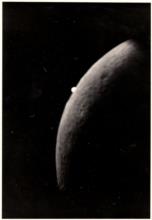
NavList:
A Community Devoted to the Preservation and Practice of Celestial Navigation and Other Methods of Traditional Wayfinding
Re: Venus occultation Monday for North America
From: Stan K
Date: 2015 Dec 7, 12:58 -0500
From: Stan K
Date: 2015 Dec 7, 12:58 -0500
I went out around 11:00 with binoculars, and, after finding the moon, a little sliver not that easy to find, nearby Venus was easy, much brighter than the moon. So I got a telescope ready. At about 12:15 the clouds started rolling in. I was hoping for a break by the time of the occultation, but it just got worse. To paraphrase Joni Mitchell, "I looked for Venus...but clouds got in the way."
Stan
-----Original Message-----
From: Frank Reed <NoReply_FrankReed@fer3.com>
To: slk1000 <slk1000@aol.com>
Sent: Fri, Dec 4, 2015 6:41 pm
Subject: [NavList] Venus occultation Monday for North America
Attached File:

(img050.jpg: Open and save)
From: Frank Reed <NoReply_FrankReed@fer3.com>
To: slk1000 <slk1000@aol.com>
Sent: Fri, Dec 4, 2015 6:41 pm
Subject: [NavList] Venus occultation Monday for North America
The Moon will occult Venus in daylight on Monday, December 7. In most of the US and Canada, you'll be able to see both the immersion and emersion events. At minimum, this is a great opportunity to see Venus in daylight without much effort. In fact, you should be able to see it easily without optical aid as a small bright dot right on the leading edge of the crescent moon a few minutes before the occultation. Here's a nice article describing the details:
http://www.skyandtelescope.com/observing/moon-flys-by-catalina-occults-venus-on-dec-7th120220150212/.
http://www.skyandtelescope.com/observing/moon-flys-by-catalina-occults-venus-on-dec-7th120220150212/.
Observing this through binoculars or a sextant or small telescope will reveal the main difficulty of using Venus for lunars. Although this is an occultation rather than a lunar, you'll see that the event takes some time since Venus has a relatively large apparent size.
I'm attaching a photo I took of a similar occultation on the morning of December 26, 1978 (film camera, of course, back then... much easier today). The dramatic contrast between Venus and the Moon is real. The Moon is actually dark grey and only appears white when our eyes are dark-adapted or camera exposures are long. But when seen side-by-side with Venus, which is really white thanks to its planet-shrouding, dense clouds, it's much more obvious that the Moon is a dark object, with low albedo.
Frank Reed
Attached File:

(img050.jpg: Open and save)






